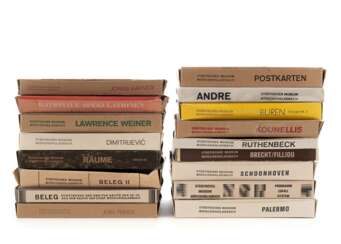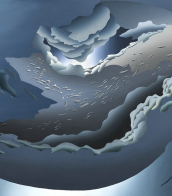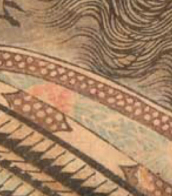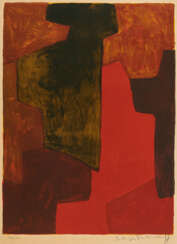städtische kunst


Walter Stöhrer is a German painter and graphic artist, a representative of gesture-figure painting.
He studied painting at the Academy of Arts in Karlsruhe and was a member of the Academy of Arts in Berlin.


Heinrich Maria Davringhausen was a German painter associated with the New Objectivity. Davringhausen was born in Aachen. Mostly self-taught as a painter, he began as a sculptor, studying briefly at the Düsseldorf Academy of Arts before participating in a group exhibition at Alfred Flechtheim's gallery in 1914. He also traveled to Ascona with his friend the painter Carlo Mense that year. At this early stage his paintings were influenced by the expressionists, especially August Macke.

 Серж Поляков. Фотопортрет художника.jpg)
Serge Poliakoff was a Russian-born French modernist painter belonging to the 'New' Ecole de Paris (Tachisme).


August Robert Ludwig Macke was an eminent German expressionist painter, founder and member of the Blue Rider association. His very colorful and individual style is today referred to as the Macke style, characterized by a harmonious combination of colors and the play of light effects. His favorite subjects of his works were sketches from the life of the city, as well as nature and man. The paintings of August Macke give an impression of joy and lightness.


Walter Ophey was a German artist. He was known for his modernist paintings, which often depicted landscapes and still-life scenes.
Ophey studied at the Academy of Fine Arts in Düsseldorf. His early work was influenced by Impressionism, but he later became associated with the Expressionist movement.
In 1909 Ophey, together with some other Düsseldorf artists, formed the artistic group the Special Union (Sonderbund). The first chairman of the Special Union was the well-known German philanthropist and collector Carl Ernst Osthaus. In the following years this group became one of the most powerful avant-garde art movements in Germany.
Ophey's paintings are characterized by their bright colors and bold, simplified forms. He often depicted rural landscapes and still-life scenes, infusing them with a sense of emotional intensity. He was also known for his use of color, which he used to convey mood and atmosphere.
Ophey's work was exhibited extensively during his lifetime, including at the Berlin Secession and the Salon d'Automne in Paris. Despite his relatively short career, he was recognized as an important figure in the development of modernist painting in Germany.


August Robert Ludwig Macke was an eminent German expressionist painter, founder and member of the Blue Rider association. His very colorful and individual style is today referred to as the Macke style, characterized by a harmonious combination of colors and the play of light effects. His favorite subjects of his works were sketches from the life of the city, as well as nature and man. The paintings of August Macke give an impression of joy and lightness.

.jpg)
Hannah Höch was a German Dada artist. She is best known for her work of the Weimar period, when she was one of the originators of photomontage. Photomontage, or fotomontage, is a type of collage in which the pasted items are actual photographs, or photographic reproductions pulled from the press and other widely produced media.
Höch's work was intended to dismantle the fable and dichotomy that existed in the concept of the "New Woman": an energetic, professional, and androgynous woman, who is ready to take her place as man's equal. Her interest in the topic was in how the dichotomy was structured, as well as in who structures social roles.
Other key themes in Höch's works were androgyny, political discourse, and shifting gender roles. These themes all interacted to create a feminist discourse surrounding Höch's works, which encouraged the liberation and agency of women during the Weimar Republic (1919-1933) and continuing through to today.


August Robert Ludwig Macke was an eminent German expressionist painter, founder and member of the Blue Rider association. His very colorful and individual style is today referred to as the Macke style, characterized by a harmonious combination of colors and the play of light effects. His favorite subjects of his works were sketches from the life of the city, as well as nature and man. The paintings of August Macke give an impression of joy and lightness.

 Серж Поляков. Фотопортрет художника.jpg)
Serge Poliakoff was a Russian-born French modernist painter belonging to the 'New' Ecole de Paris (Tachisme).


Karl Hofer was a German expressionist painter. He was director of the Berlin Academy of Fine Arts.
One of the most prominent painters of expressionism, he never was a member of one of the expressionist painting groups, like "Die Brücke", but was influenced by their painters. His work was among those considered degenerate art by the Nazis, but after World War II he regained recognition as one of the leading German painters.


Carlo Mense was a German artist of the twentieth century. He is known as a painter and graphic artist, a representative of Rhenish Expressionism and New Materialism.
Mense was a member of artists' associations such as the Cologne Secession, Gereon Club, Young Rhine, and November. He actively participated in Expressionist exhibitions. Creating graphic works for the magazines "Action" and "Sturm", he became known for his artistic style. In 1937, the Nazis destroyed 37 of his works, categorizing them as "degenerate art." Mense left a significant mark on twentieth-century German painting with his expressive and evocative works.


August Robert Ludwig Macke was an eminent German expressionist painter, founder and member of the Blue Rider association. His very colorful and individual style is today referred to as the Macke style, characterized by a harmonious combination of colors and the play of light effects. His favorite subjects of his works were sketches from the life of the city, as well as nature and man. The paintings of August Macke give an impression of joy and lightness.

 Серж Поляков. Фотопортрет художника.jpg)
Serge Poliakoff was a Russian-born French modernist painter belonging to the 'New' Ecole de Paris (Tachisme).

.jpg)
Max Ernst was a pivotal figure in the 20th-century art world, whose work transcended the boundaries of nationality and genre to leave an indelible mark on culture, art, sculpture, and painting. Born in Germany on April 2, 1891, and later becoming a naturalized American and French citizen, Ernst's career was a testament to his relentless innovation and creativity. Known primarily as an artist and painter, Ernst was a founding member of the Dada movement in Cologne before becoming a major proponent of Surrealism in Paris. His early encounters with the works of Pablo Picasso, Vincent van Gogh, and Paul Gauguin at the Sonderbund exhibition in 1912 deeply influenced his artistic direction, infusing it with elements of Cubism and Expressionism. Despite his lack of formal artistic training, Ernst's experimentation with techniques such as collage and frottage showcased his unique ability to blend the absurd with the sublime, making him a central figure in the artistic avant-garde of his time.
Ernst's work is notable for its exploration of the unconscious, using dreamlike imagery and symbolic figures to critique societal norms and delve into the chaos of the human psyche. His experiences in World War I profoundly impacted his worldview, leading to a deep skepticism of Western culture and an enduring search for meaning through art. This is evident in works such as "Europe After the Rain II," which reflects the devastation of war and "The Fireside Angel," inspired by the political turmoil of the Spanish Civil War, showcasing his ability to address contemporary issues through a surreal lens.
Ernst's contributions to art are preserved in major museums and galleries worldwide, including the Tate in the United Kingdom and the Museum of Modern Art in New York. His sculptures, paintings, and collages continue to be celebrated for their innovative techniques and imaginative scope, marking him as a revolutionary figure in modern art. Among his most significant works are "Ubu Imperator," "The Elephant Celebes," and "The Virgin Spanking the Christ Child before Three Witnesses," each reflecting his mastery over a diversity of mediums and themes.
For collectors and experts in art and antiques, Max Ernst remains a symbol of artistic freedom and exploration. His ability to navigate through various artistic movements while maintaining a distinct, innovative voice is a testament to his enduring legacy in the art world. To stay updated on new product sales and auction events related to Max Ernst, signing up for updates is a valuable opportunity for those deeply invested in the nuances of modern and surreal art.









































































